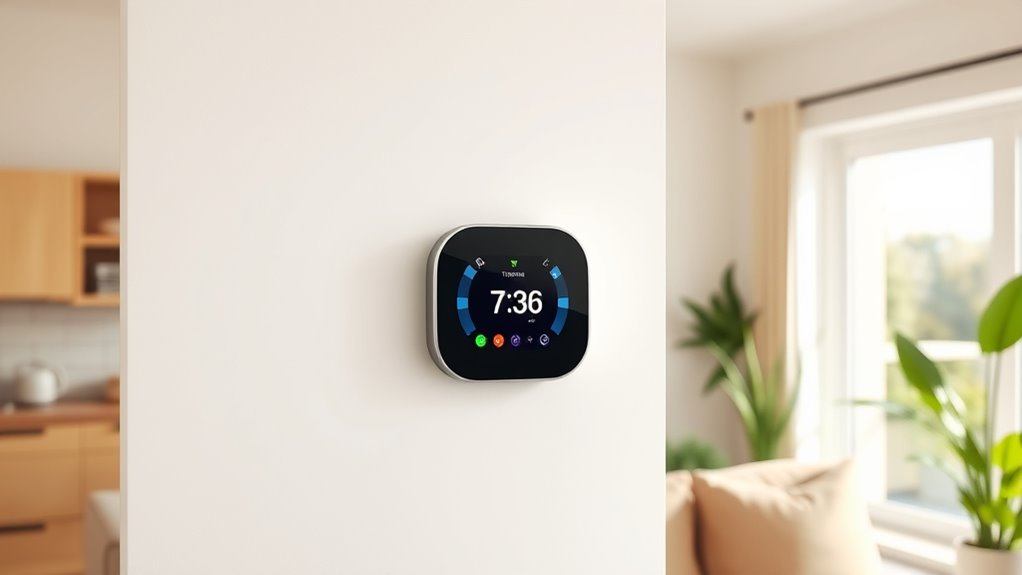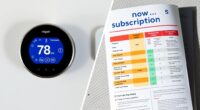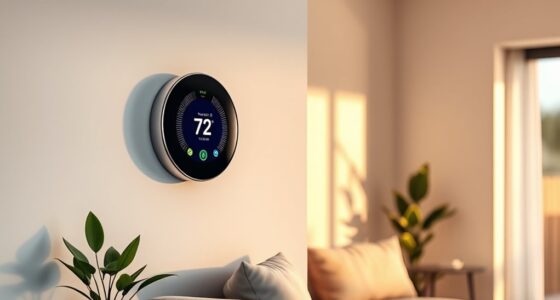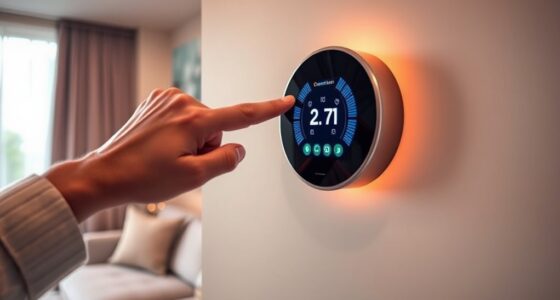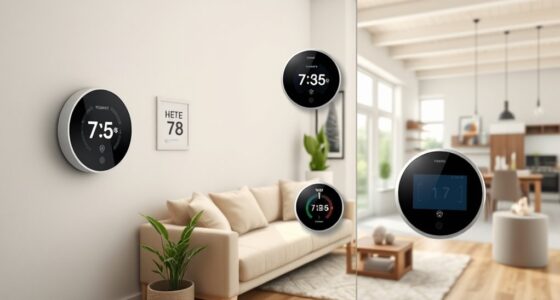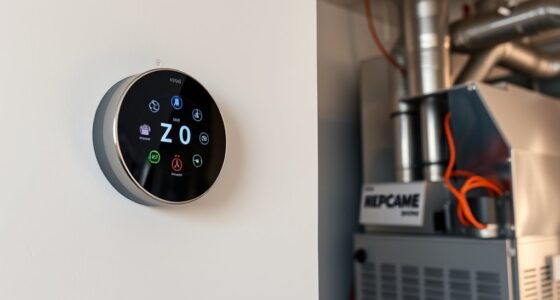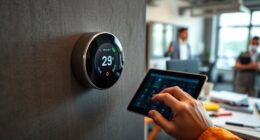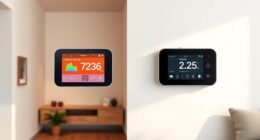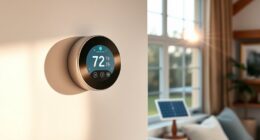When choosing smart thermostats for your vacation rental, focus on compatibility with your HVAC system and easy installation. Look for models with learning capabilities that analyze guest preferences and automate temperature adjustments. Prioritize features like remote control and guest-friendly interfaces to guarantee comfort without overspending energy. Additionally, consider integration with heat pumps and smart home systems for enhanced control. Continue exploring to discover how to optimize these devices for both guest satisfaction and energy savings.
Key Takeaways
- Ensure compatibility with existing HVAC or heat pump systems for seamless integration and optimal performance.
- Prioritize models with learning capabilities and automated scheduling to efficiently balance guest comfort and energy savings.
- Choose user-friendly interfaces with control limits to allow guest adjustments while maintaining energy efficiency.
- Confirm remote control and support features for easy management and troubleshooting from anywhere.
- Consider integration with smart home systems and sustainability features to enhance overall property value and operational efficiency.
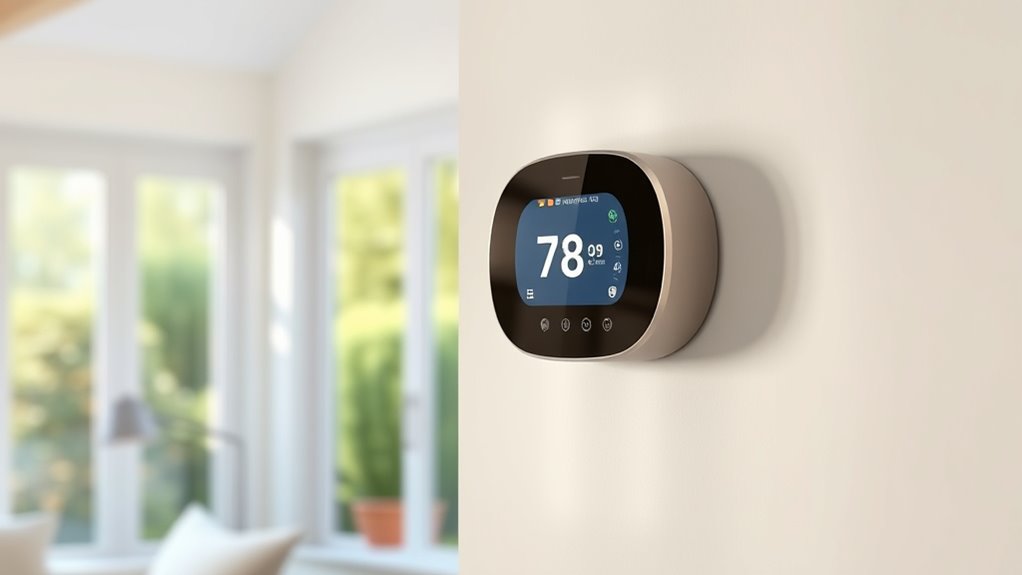
When managing vacation rentals, ensuring guest comfort while maintaining energy efficiency can be challenging. You want your guests to feel at home, comfortable, and relaxed, but you also need to keep operating costs in check. That’s where smart thermostats come into play. They offer a perfect balance between energy savings and guest comfort, allowing you to control the temperature efficiently without sacrificing guest satisfaction. These devices learn your guests’ preferences over time, adjusting settings automatically to provide a cozy environment while minimizing unnecessary energy use.
Choosing the right smart thermostat involves considering compatibility with your existing HVAC system. Not all models work with every setup, so it’s essential to verify compatibility before making a purchase. Once installed, a good smart thermostat can be easily controlled remotely via smartphone apps, giving you the ability to adjust temperatures before guests arrive or while they’re away. This flexibility helps prevent energy waste and ensures that the rental is always at the ideal temperature when occupied. Plus, many models allow guests to make simple adjustments within set parameters, enhancing their comfort without risking excessive energy consumption.
Another key factor is the thermostat’s learning capabilities. Modern smart thermostats analyze occupancy patterns and temperature preferences over time, automatically optimizing heating and cooling schedules. This means you don’t have to manually adjust settings constantly, saving you time and energy. These intelligent features help maintain a comfortable environment while drastically reducing utility bills, making your rental more sustainable and cost-effective. Additionally, some models include features like geofencing, which detects when guests are approaching or leaving, adjusting the temperature accordingly. This proactive approach ensures energy isn’t wasted when the property is unoccupied, while still providing a warm welcome when guests arrive.
Ease of use is also critical. The best smart thermostats have intuitive interfaces and straightforward setup processes, so you can get them up and running quickly. Guest interaction should be simple—allowing them to control the temperature within predefined limits to ensure comfort without jeopardizing energy savings. When guests enjoy a comfortable stay without the hassle of manual adjustments, it improves their experience and encourages positive reviews. Understanding energy management through smart thermostats can significantly enhance your rental’s efficiency and guest satisfaction. Furthermore, integrating smart thermostats with best heat pump systems can improve overall climate control, especially in regions with extreme weather conditions. Also, many support remote support hours, making troubleshooting more convenient if issues arise during operation.
Frequently Asked Questions
Can Smart Thermostats Be Integrated With Existing Home Automation Systems?
You can definitely integrate smart thermostats with your existing home automation systems. Check the device’s integration compatibility to make sure it works seamlessly with your setup. Many smart thermostats offer system customization options, allowing you to tailor features to your needs. By confirming compatibility and customization capabilities, you’ll create a smoother, more efficient automation experience, making your vacation rental more comfortable and energy-efficient.
What Are the Security Risks of Installing Smart Thermostats in Rentals?
When considering smart thermostats, you’re walking a tightrope with security risks. You need to protect guest privacy and guarantee data encryption so sensitive information stays safe. Hackers could exploit vulnerabilities, leading to unauthorized access or data breaches. To keep everything above board, always update firmware, use strong passwords, and choose devices with robust security features. Think of it as locking the door before trusting someone inside.
How Do Smart Thermostats Handle Power Outages or Connectivity Issues?
When facing power outages or connectivity issues, smart thermostats often have built-in power outage management features like backup batteries, allowing them to retain settings temporarily. They also support connectivity troubleshooting, such as switching to local control or using cellular networks if Wi-Fi drops. This guarantees your rental’s climate remains stable, and you can manage settings remotely once power or connection is restored.
Are There Specific Smart Thermostat Models Ideal for Short-Term Rentals?
Imagine waking up to a cozy, perfectly heated space in your rental—without lifting a finger. Certain smart thermostats are ideal for short-term rentals because they combine energy-saving features with guest control options. Models like the Nest Learning Thermostat or Ecobee SmartThermostat offer intuitive interfaces and remote access, making it easy to manage temps efficiently and guarantee your guests stay comfortable, all while saving energy during their stay.
What Is the Average Cost and Return on Investment for Smart Thermostats?
You might wonder about the average cost and ROI for smart thermostats. Typically, they cost between $100 and $250, depending on features. Their energy savings can reduce utility bills by up to 10-15%, increasing your rental value. Over time, these savings and improved tenant comfort boost your investment’s return. Plus, a smart thermostat can enhance your property’s appeal, making it more attractive to short-term renters.
Conclusion
Choosing the right smart thermostat for your vacation rental means saving energy, enhancing guest comfort, and simplifying management. It means investing in convenience, security, and efficiency. It means making your property smarter, your guests happier, and your life easier. By considering these key factors, you set your rental up for success. So, take the time, make the right choice, and watch your vacation rental thrive with smarter technology. Your guests and your bottom line will thank you.
